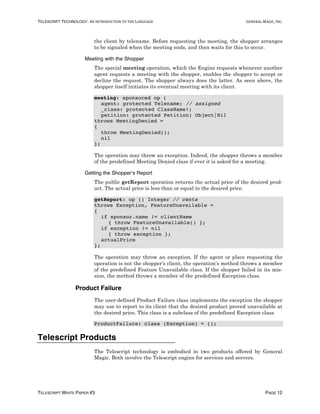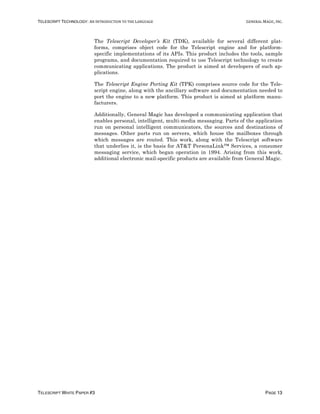The document introduces Telescript technology, which allows software agents to transport themselves across networks. It describes the electronic marketplace enabled by Telescript, where agents of consumers and providers can interact. The Telescript language allows agents to travel between "places" using a single "go" instruction and meet other agents using a "meet" instruction. Examples show how a warehouse and shopper agents use these instructions to browse and purchase products in the electronic marketplace.
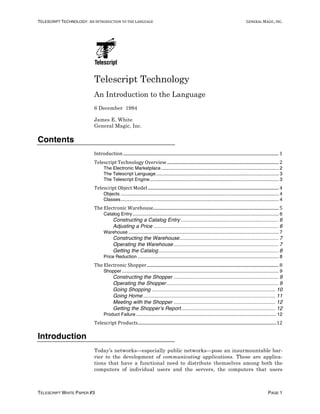

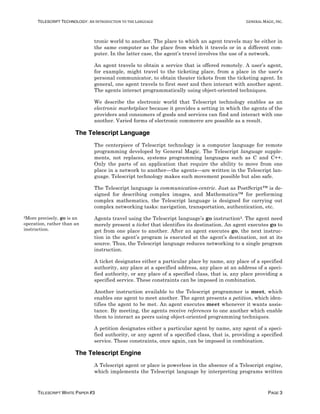
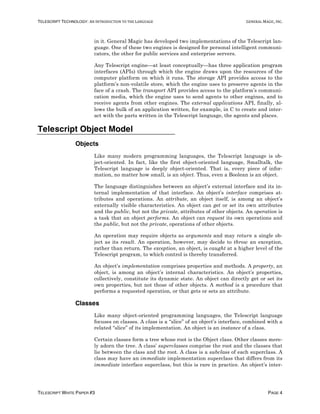
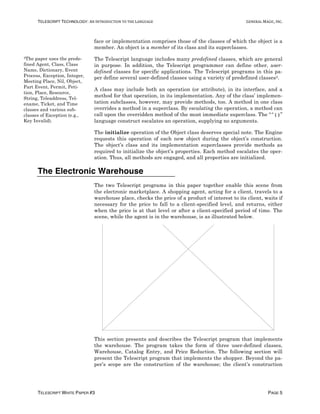
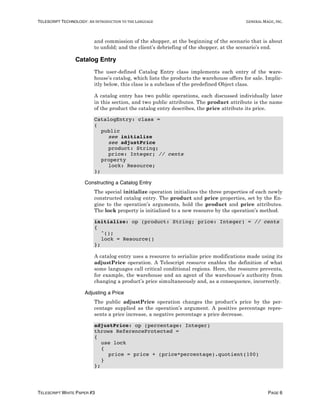
![TELESCRIPT TECHNOLOGY: AN INTRODUCTION TO THE LANGUAGE GENERAL MAGIC, INC.
TELESCRIPT WHITE PAPER #3 PAGE 7
A catalog entry, as mentioned before, uses a resource to serialize price modi-
fications. Here the “use” construct excludes one agent (or place) from the
block of instructions in braces, so long as another is executing them.
The operation may throw an exception. If the catalog entry is protected from
modification, the Engine throws a member of the predefined Reference Pro-
tected class. If the shopper tried to change the price, this would be the result.
Warehouse
The user-defined Warehouse class implements the warehouse. This class is a
subclass of the predefined Place and Event Process classes.
A warehouse has three public operations, each discussed individually later in
this section.
Warehouse: class (Place, EventProcess) =
(
public
see initialize
see live
see getCatalog
property
catalog: Dictionary[String, CatalogEntry];
);
Constructing the Warehouse
The special initialize operation initializes the one property of a newly con-
structed warehouse. The catalog property, set by the Engine to the opera-
tion’s argument, holds the warehouse’s catalog. Each catalog key is assumed
to equal the product attribute of the corresponding catalog value.
initialize: op (
catalog: owned Dictionary[String, CatalogEntry]) =
{
^()
};
A predefined operation beyond the scope of this paper is used to construct a
new place. If an agent or place that is not permitted to construct a warehouse
tries to do so, or the place in which the warehouse is to be erected—places are
nested—blocks construction, the operation throws an exception.
Operating the Warehouse
The special live operation operates the warehouse on an ongoing basis. On
the first of each month, unbeknownst to its customers, the warehouse reduces
by 5% the price of each product in its catalog.
live: sponsored op (cause: Exception|Nil) =
{
loop {
// await the first day of the month
time: = Time();
calendarTime: = time.asCalendarTime();
calendarTime.month = calendarTime.month + 1;
calendarTime.day = 1;](https://image.slidesharecdn.com/935503c5-da31-40f2-bc2d-e0c2966fc25f-151222233556/85/Telescript-White-Paper-3-7-320.jpg)
![TELESCRIPT TECHNOLOGY: AN INTRODUCTION TO THE LANGUAGE GENERAL MAGIC, INC.
TELESCRIPT WHITE PAPER #3 PAGE 8
*.wait(calendarTime.asTime().interval(time));
// reduce all prices by 5%
for product: String in catalog
{
try { catalog[product].adjustPrice(-5) }
catch KeyInvalid { }
};
// make known the price reductions
*.signalEvent(PriceReduction(), 'occupants)
}
};
The Engine requests the live operation of each newly constructed place. The
operation gives, in this case, the warehouse a life of its own. The warehouse
sponsors the operation, that is, performs it under its own authority and sub-
ject to its own permit. The operation, on the first of each month, reduces by
5% the price of each product the warehouse carries, and signals the event to
any agents occuping the warehouse at the time. The “*.” construct directs
the request for the signalEvent operation to the warehouse itself. A Tele-
script event is an incident or condition one agent or place reports to another.
Getting the Catalog
The public getCatalog operation returns a reference to the warehouse’s cat-
alog. Unless the agent or place requesting the operation is of the warehouse’s
authority, the reference protects the catalog from modification. The latter is
likely, for example, when the shopper requests the operation.
getCatalog: op () Dictionary[String, CatalogEntry] =
{
if sponsor.name.authority == *.name.authority {catalog}
else {catalog.protect()@}
};
One agent or place can determine the authority of any other agent or place
with which it interacts. Using the “sponsor” construct, the warehouse ob-
tains a reference to the agent (or place) under whose authority the catalog is
requested. After comparing its own name attribute to the agent’s, the ware-
house returns either a protected or an unprotected reference to the catalog.
Price Reduction
The user-defined Price Reduction class implements each event represented by
the warehouse’s reduction of a product’s price. The warehouse notifies of such
an event any agent that happens to occupy the warehouse at the time of the
reduction. This class is a subclass of the predefined Event class.
PriceReduction: class (Event) = ();
The Electronic Shopper
This section presents and describes the Telescript program that implements
the shopper. The program takes the form of two user-defined classes, Shopper
and Product Failure.](https://image.slidesharecdn.com/935503c5-da31-40f2-bc2d-e0c2966fc25f-151222233556/85/Telescript-White-Paper-3-8-320.jpg)


![TELESCRIPT TECHNOLOGY: AN INTRODUCTION TO THE LANGUAGE GENERAL MAGIC, INC.
TELESCRIPT WHITE PAPER #3 PAGE 11
while actualPrice > desiredPrice
{
*.getEvent(nil, PriceReduction());
try
{
actualPrice =
here@Warehouse.getCatalog()[desiredProduct].price
}
catch KeyInvalid { throw ProductFailure() }
}
};
This operation takes the shopper to the warehouse using the go operation.
The shopper provides a ticket identifying the class, but neither the telename
nor the teleaddress, of its destination. In an electronic marketplace of even
moderate size, or encompassing two or more warehouses, this approach
would not suffice. Arriving at the warehouse, the shopper expresses an inter-
est in the price reduction event, which it knows the warehouse will signal4.
Each time it learns of a price reduction, the shopper checks the price of the
desired product and, if the price reduction was insufficient, waits for another.
The operation may throw an exception. If the warehouse doesn’t carry the
desired product, the Engine throws a member of the user-defined Product
Failure class. If the product were nonexistent, this would be the outcome.
Going Home
The private goHome operation is requested of the shopper by the shopper
itself. By means of this operation, the shopper goes back to the place from
which it started, and there meets with its client. The meeting gives the client
a chance to request the shopper’s getReport operation. When the client later
parts from the shopper, ending the meeting, the operation succeeds.
goHome: op (homeName: Telename; homeAddress: Teleaddress) =
{
// drop excess baggage
*.disableEvents();
*.clearEvents();
// go home
*.go(Ticket(homeName, homeAddress));
// meet the client
*.enableEvents(PartEvent(clientName));
here@MeetingPlace.meet(Petition(clientName));
// wait for the client to end the meeting
*.getEvent(nil, PartEvent(clientName))
};
This operation takes the shopper home, again using the go operation. The
shopper provides a ticket identifying both the telename and the teleaddress
of its destination. Before leaving the warehouse, the shopper withdraws its
interest in price reductions, and discards any price reductions of which it may
have been notified, but upon which it has not yet acted5. Upon arriving home,
the shopper meets with its client. The shopper supplies a petition identifying
4To prime the pump, the
shopper signals itself of one
such event.
5By discarding any unpro-
cessed signals, the agent
lightens its load.](https://image.slidesharecdn.com/935503c5-da31-40f2-bc2d-e0c2966fc25f-151222233556/85/Telescript-White-Paper-3-11-320.jpg)
